River Pollution Facts
-
1. Sewage was dumped into waterways on at least 375,000 occasions in 2022
Sewage was dumped intentionally into waterways in England and Wales on at least 375,000 occasions in 2022 for a combined total of 2.3 million hours.
The www.top-of-the-poops.org website lists sewage dumps in detail. You can search for the results in your constituency, and for rivers or beaches near you.
-
2. Monitoring and enforcement budgets down 56% since 2009/10
Since 2009/10, responsibility for enforcing standards has fallen increasingly to the water companies themselves, with the Environment Agency’s environmental protection budget cut by 56%.
Despite only 14% of English rivers achieving ‘Good’ ecological status, and none achieving ‘Good’ chemical status, prosecutions of water companies have fallen sharply, and in 2021 were 95% down on 2011.
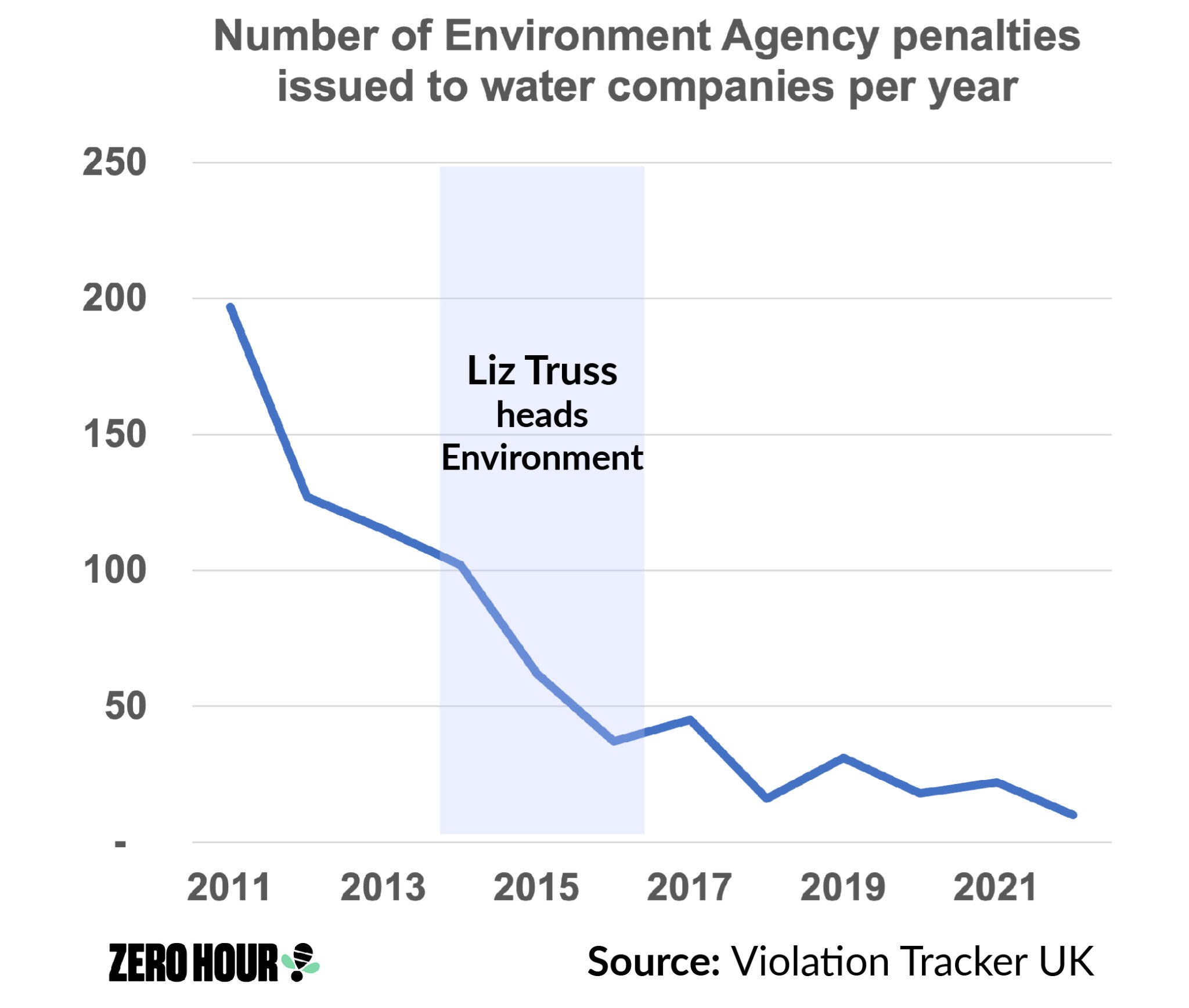
Under Liz Truss’ leadership of as head of Environment, £235 million was cut from the Environment Agency’s budget.
Government monitoring has been cut back, but the water companies are also not monitoring sewage discharges effectively.
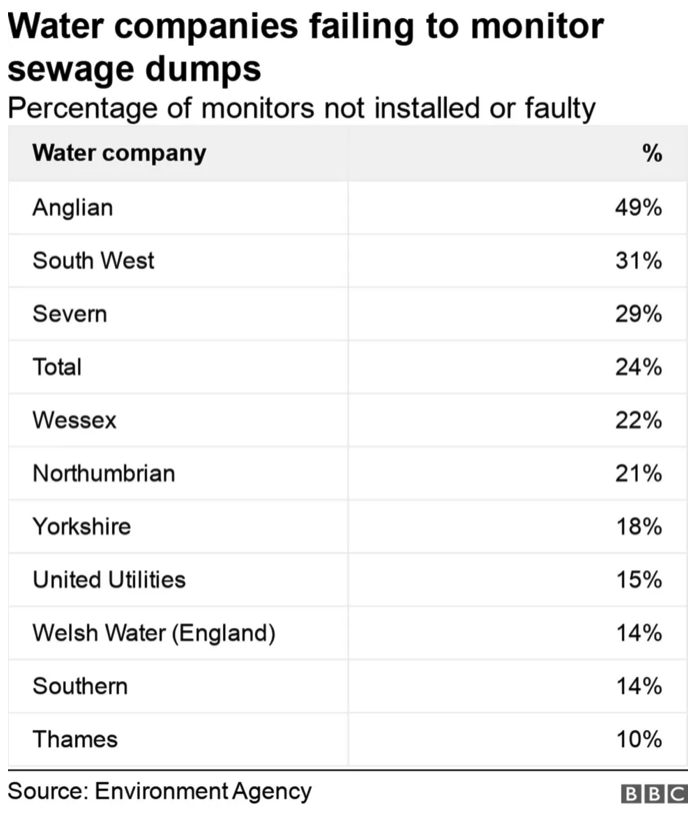
-
3. Did MPs vote to dump raw sewage in rivers in Oct/Nov 2021?
In October 2021, the Government voted against an amendment to the Environment Act proposed by the House of Lords. This ‘Lords Amendment’ (1) would have forced rapid action on sewage by the water companies and (2) would have made it obligatory for the Government to enforce the rules. The Government’s compromise made enforcement optional, and softened the responsibility on water companies.
What the Lords Amendment would have done:
- Put tighter controls on water companies to take all reasonable steps to reduce the harm caused by dumping sewage – from all parts of the sewage system.
- Created a requirement that the Secretary of State and the Environment Agency must enforce the rules. Note that enforcement actions have fallen by 95% since 2011.
The final Government Version
After concerns were raised, the Government passed a modified version of the clause in Nov 21 which:
- refers to ‘adverse impacts’ rather than ‘reductions in harm’, a looser requirement according to NGOs and legal experts.
- limits the clause to storm overflows only – not the entire sewage system as specified by the Lords.
- Removes the requirement for the Government and the Environment Agency to enforce the rules – noting simply that the duty on water companies is enforceable rather than saying the EA must enforce the rules. This is quite significant.
- The language of taking all reasonable steps was removed.
The full text
For those who want to check for themselves, below is the clause proposed by the House of Lords, and the final Government version.
1. Original Lords’ Amendment
“141A Duty on sewerage undertakers to take all reasonable steps to ensure untreated sewage is not discharged from storm overflows:
- A sewerage undertaker must demonstrate improvements in the sewerage systems and progressive reductions in the harm caused by untreated sewage discharges.
- The Secretary of State, the Director and the Environment Agency must exercise their respective functions under this and any other Act to secure compliance with this duty.”
2. The final Government version
“141DC Reduction of adverse impacts of storm overflows
(1) A sewerage undertaker whose area is wholly or mainly in England must secure a progressive reduction in the adverse impacts of discharges from theundertaker’s storm overflows.
(2) The reference in subsection (1) to reducing adverse impacts includes—
(a) reducing adverse impacts on the environment, and
(b) reducing adverse impacts on public health.
(3) The duty of a sewerage undertaker under this section is enforceable [rather than ‘must be enforced’] under section 18 by—
(a) the Secretary of State, or
(b) the Authority with the consent of or in accordance with a general authorisation given by the Secretary of State.”
More info
- The Rivers Trust explain that the wording of the government’s amendment is weaker, with too much room for broad interpretation. They also warn that the amendment is limited just to storm overflows and not the entire sewage system. This information was provided to Government in a joint parliamentary briefing by Surfers against Sewage, Trout & Salmon Conservation, The Angling Trust, and The Rivers Trust.
-
4. Water company investment has fallen sharply whilst debt has risen
According to the Financial Times, Britain’s water and sewage companies have ‘slashed investment in critical infrastructure by up to a fifth in the 30 years since they were privatised.’
At the same time, water bills have increased 31% in real terms since the 1990’s and a total of £72 billion has been paid out to investors.
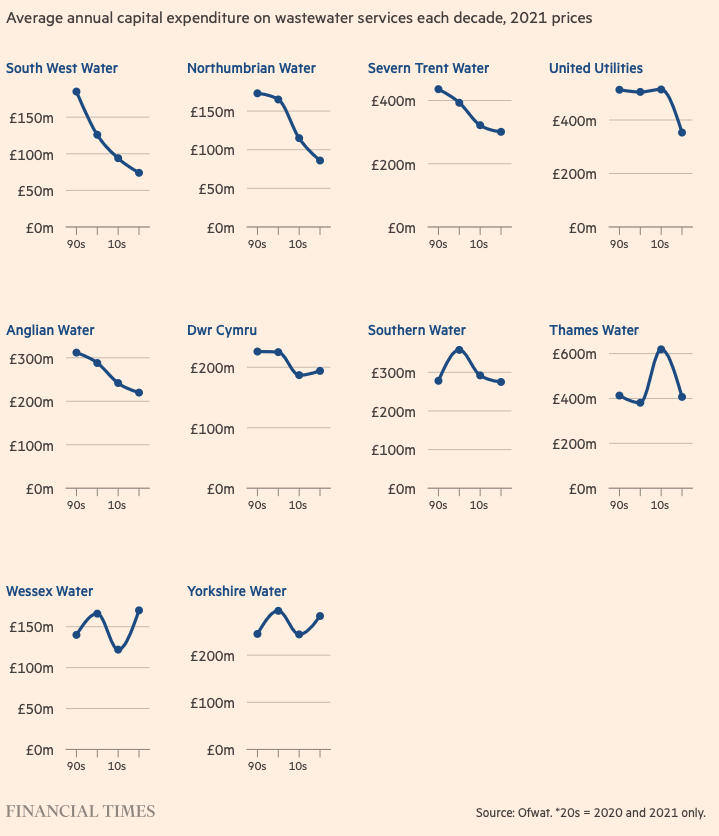
Water companies knew that population was growing and surface water run-off due was rising due to climate change and to the trend of paving over gardens for parking. So they should have increased investment, not cut it. Private companies of course seek to maximise their profits. That is why it is the role of Government regulators to ensure that the companies provide the service levels required.
Debt has been used to pay dividends instead of to invest
The Financial Times reports that water companies have increased borrowings in order to pay dividends rather than invest in the sewage system. The FT say that ‘On a combined basis, customers today pay about £1.2bn a year — or £53 a year per household — servicing the debt’.
The Guardian reports that ‘Ofwat is refusing to limit the soaring debts run up by water companies as research reveals the firms have outstanding borrowing of almost £54bn accrued since privatisation’.
-
5. Targets for achieving 'Good' status by 2027 but 98% rated as 'low confidence'
The Government’s new Environmental Improvement Plan (Jan 2023) contains the following commitment (p99):
- Restore 75% of our water bodies to good ecological status.
But there is no target date in contrast with other targets on the same page.
Instead, the UK has issued a series of targets to reduce the pollutants going into rivers and the sea. However, as we highlight in the following FAQs, these targets are weak.
DEFRA ‘Objectives’
Ecological Objectives
DEFRA offer the following ‘Objectives’ for England, but DEFRA warn that 98% of 2027 objectives are unlikely to be achieved (see circled statement). It is not surprising DEFRA have made this qualification given the weak targets on pollution – as explained in the FAQs below.
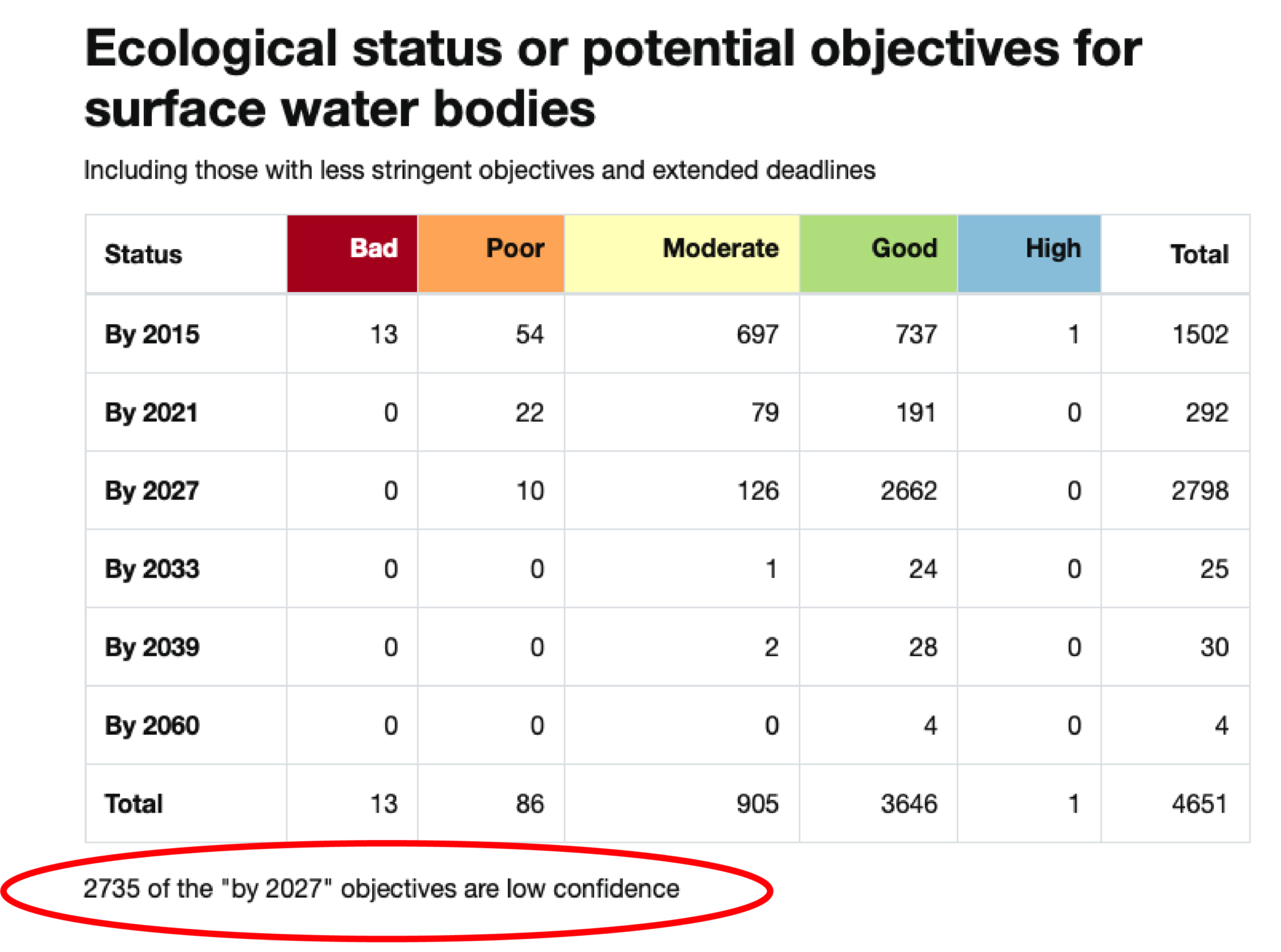
Chemical Objectives
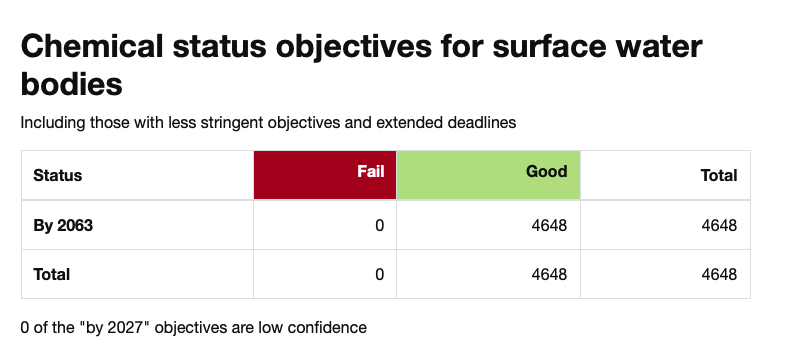
DEFRA have issued a statement to explain that the very distant 2063 target is because persistent ‘forever’ chemicals (such as PFAS) will take a long time to dissipate. They say: “The 2063 date for these persistent chemicals mentioned is not a new target, it is a modelling prediction by the Environment Agency on how long it will take for the levels to dissipate.”
However we are concerned that the Environment Agency is either not testing for forever chemicals – or only testing for a very small portion of them. To be confirmed. In the absence of robust targets and monitoring, how can we ensure that improvements are being made?
Water Framework Directive
The Water Framework Directive is a piece of EU legislation designed to ensure all European waters (rivers, lakes, groundwater, and coastal waters) achieve Good ecological status by 2027. It was transcribed into UK law, but the UK Water Framework Directive (2017) is now at risk of being revoked later in 2023 by the Retained EU Law (Revocation and Reform) Bill – or REUL. See ClientEarth.
That would remove the legal obligation for water bodies to achieve Good ecological status by 2027.
If the Government does indeed intend to revoke the legislation containing the 2027 target, that might well explain the unusual absence of a target date for achieving Good ecological status in the new Environmental Improvement Plan.
EU taking Ireland to court for failing to commit to EU target for all water bodies to achieve ‘Good’ status by 2027
It is worth noting that EU members are obliged to create legal targets to bring all water bodies (rivers, estuaries etc) to ‘Good‘ status by 2027 under EU law. The EU Commission last month referred Ireland to the Court of Justice of the European Union for failing to commit in national law to the 2027 target.
-
6. Targets on sewage outflows allow majority to continue dumping raw sewage until 2050
The Government’s Storm Overflows Discharge Reduction Plan sets out three key targets for reducing the dumping of raw sewage – for England.
Target 1: Protecting Nature
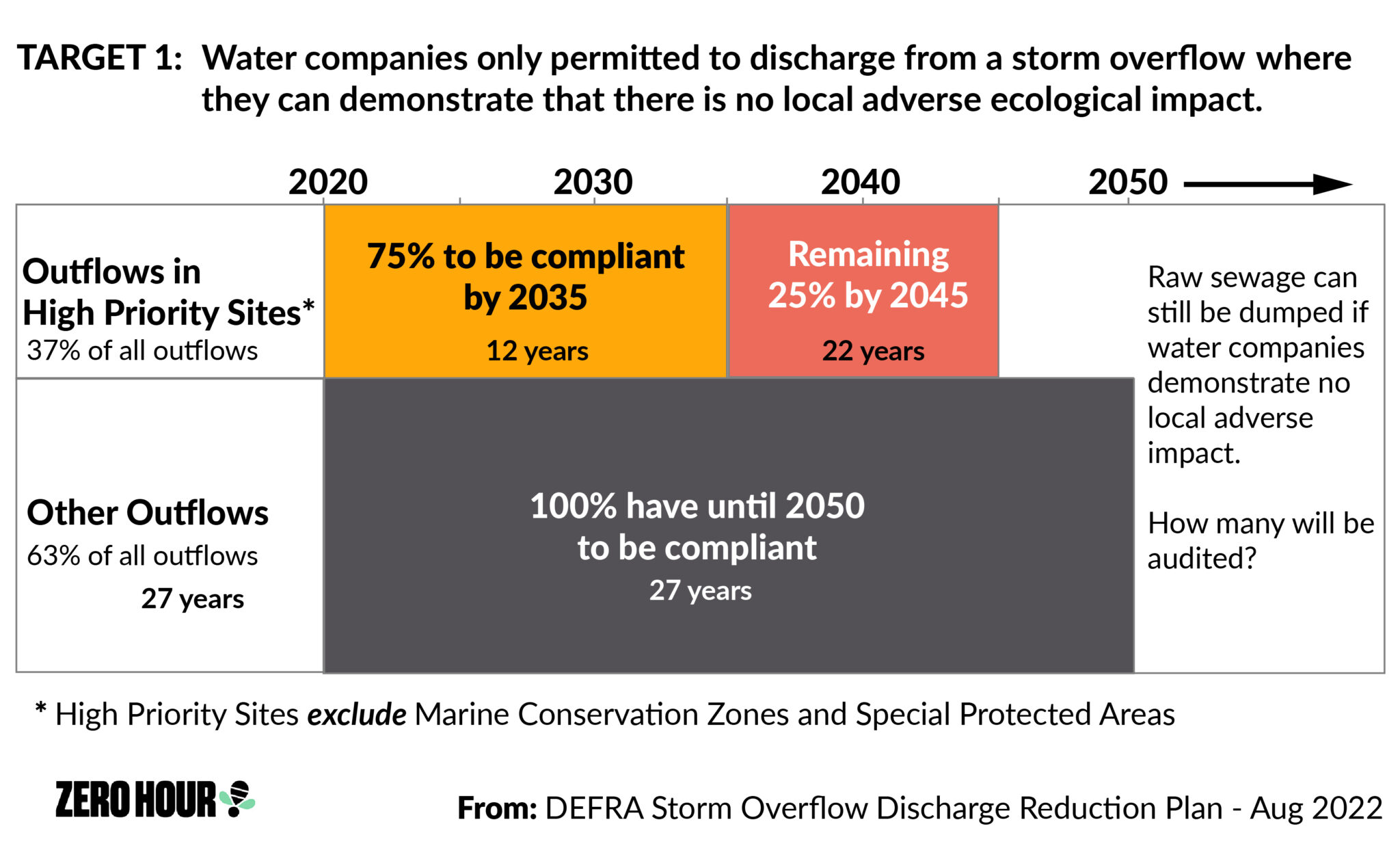
Weaknesses:
- There is no doubt that the cost to upgrade our sewage system will be significant, and Government must consider this carefully. But 2050 for the majority of outflows is far too slow, with rivers already under severe pressure.
- See next two FAQs on whether stricter targets for high priority areas go far enough, and on lower standards for estuarine and coastal waters.
- Note: Government’s new Environmental Improvement Plan contradicts the above targets, stating (p99) that water companies must “have eliminated all adverse ecological impact from sewage discharges at all sensitive sites by 2035“. So why is this target looser, extending the target to 2045 for 25% of high priority outflows?
Target 2: Protecting Humans – at bathing sites
By 2035, water companies must “significantly reduce harmful pathogens from storm overflows discharging into and near designated bathing waters, by either:
- applying disinfection (we don’t like the sound of that!); or
- reducing the frequency of discharges to an average of three spills per bathing season for a “Good” rating or two spills for “Excellent”.
A single ‘spill’ event is defined as anything up to 12 hours.
Target 3: Ensuring storm overflows operate only in unusually heavy rainfall events
Target date: 2050 for all outflows. After the target, overflows will still be permitted an average of up to 10 rainfall events per year. Each ‘event’ can last up to 12 hours, so that is 120 hours of raw sewage from each outflow per year.
Sewage outflows in estuaries and coastal waters are excluded from this target. DEFRA say this is because the sewage will be adequately diluted in these larger bodies of water. See ‘Lower standards for sewage outlets into estuaries and the sea‘ for our response.
-
7. Stricter targets for high priority sites exclude Marine Conservation Zones and rely on self reporting
Target 1 in the Storm Overflows Discharge Reduction Plan will prohibit dumping of raw sewage from storm overflows unless the water company ‘can demonstrate there is no local adverse ecological impact’.

Weaknesses
- Marine Conservation Zones (MCZs) and Special Protected Areas (SPAs) are excluded from the list of high priority areas – despite being important for protecting sensitive habitats and species. They will therefore be subject to harm until 2050. This is contrary to the Environment Act target: 70% of designated features in Marine Protected Areas (Including MCZs and SPAs) to be in favourable condition by 2042 with the remainder in recovering condition, with a new interim target of 48% of designated features to be in favourable condition by 31 January 2028. The Marine Conservation Society says that of 180 Marine Protected Areas in England, over half had at least one Combined Storm Overflow within 1km, which spilt sewage more than 10 times in 2021. Many of the overflows are adjacent to hotspots for seagrass – vitally important for carbon sequestration.
- Water companies can self-certify that there is no adverse impact and continue dumping sewage. With dramatic cuts to Environment Agency monitoring budgets, what will keep the water companies honest?
- Harmful chemicals, such as pesticides and ‘forever’ chemicals are not measured (e.g. PFAS), ignoring the latest scientific evidence. The definition of ‘adverse ecological harm only includes indicators for ammonia and dissolved oxygen.
- There is no target or monitoring for Microplastics, which are damaging to marine life. They absorb high concentrations of toxins and have now entered the human food chain, with early evidence of damaging consequences to human cells. A recent study found microplastics in 100% of mussel samples from UK waters. Treating sewage removes 99% of microplastics, but when raw sewage is dumped into waterways, that vital screening does not happen. Continuing to permit this until 2045 seems very unwise.
-
8. Lower standards for sewage outlets into estuaries and the sea ('Target 3')
The new target of ‘ensuring that storm overflows only operate in heavy rain’ does not apply to estuaries or the sea, unless there’s a nearby bathing area. Estuaries are one of our most important wildlife habitats.
This is target (3) on p12 of the Storm Overflows Discharge Reduction Plan published in Aug 2022. DEFRA say that this exclusion for estuaries and the sea is because the sewage is adequately diluted in the larger volumes of water involved.
However this approach is not based on scientific evidence and seems particularly unwise given given Defras own assessments that:
- Only 29% of estuarine and coastal waters meet ‘Good’ ecological standards, with every single one failing chemical standards.
- 75% of shellfish waters fail water quality standards.
- Sewage outflows contain ‘forever chemicals’ like PFAS and microplastics which are extremely damaging to delicate marine environments, and find their way back into the human food chain. The Marine Conservation Society explain that the latest evidence shows that these pollutants are not safely diluted in estuaries or the sea.
- There’s nothing to stop water companies diverting raw sewage from upper river locations and dumping it in estuaries.
-
9. Agricultural pollution overlooked - no target on pesticides or animal waste
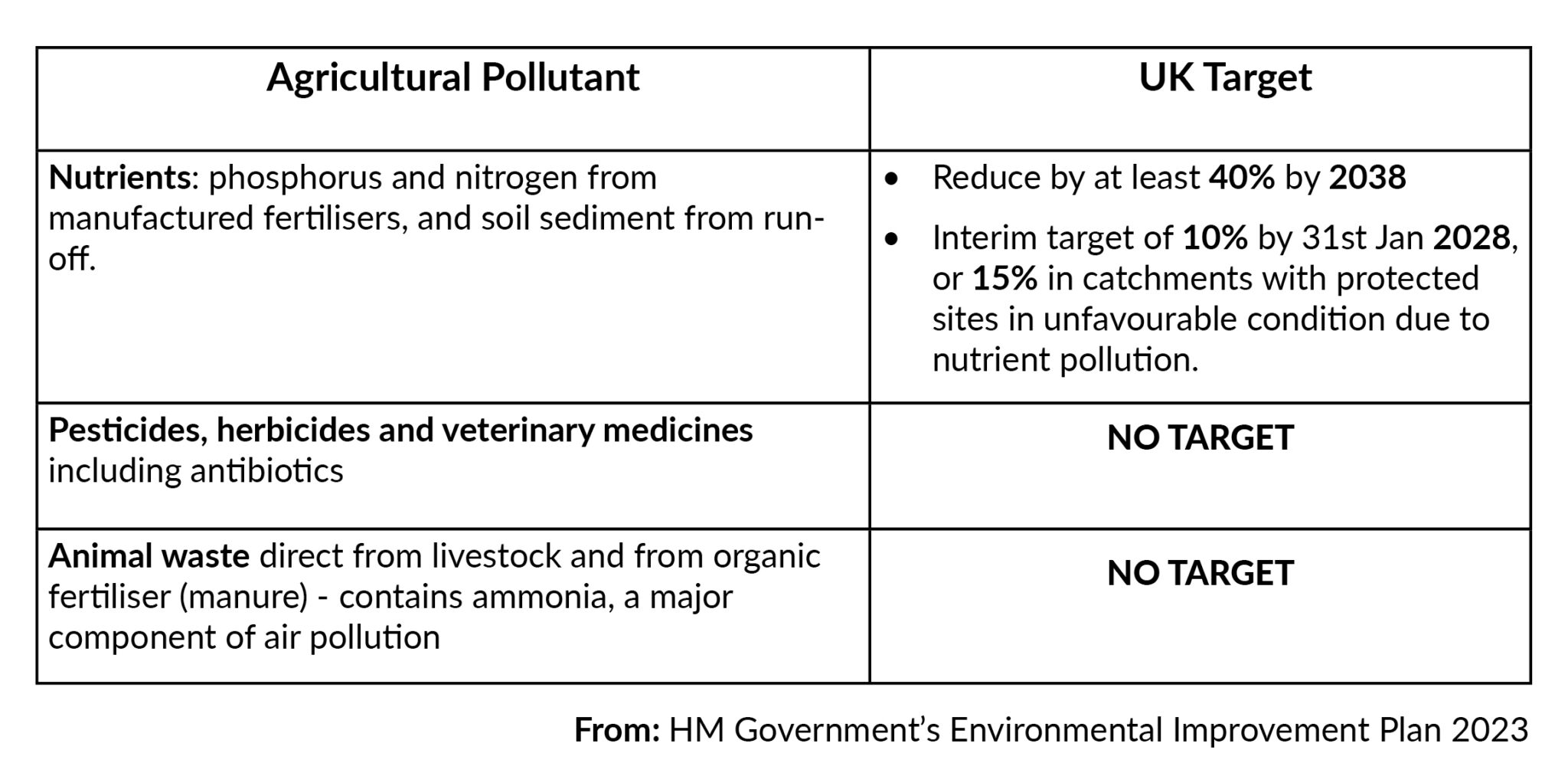
The Environmental Improvement Plan (EIP) shows that the Government only has a target for nutrient pollution, and that target is unambitious. Other dangerous pollutants have no target at all:

A 2022 report from the Environmental Audit Committee finds that pollution from agriculture is the main cause of water bodies failing to meet ‘Good Ecological Status’. Agricultural pollution is causing 40% of water bodies to fail followed by sewage and waste water at 36%.
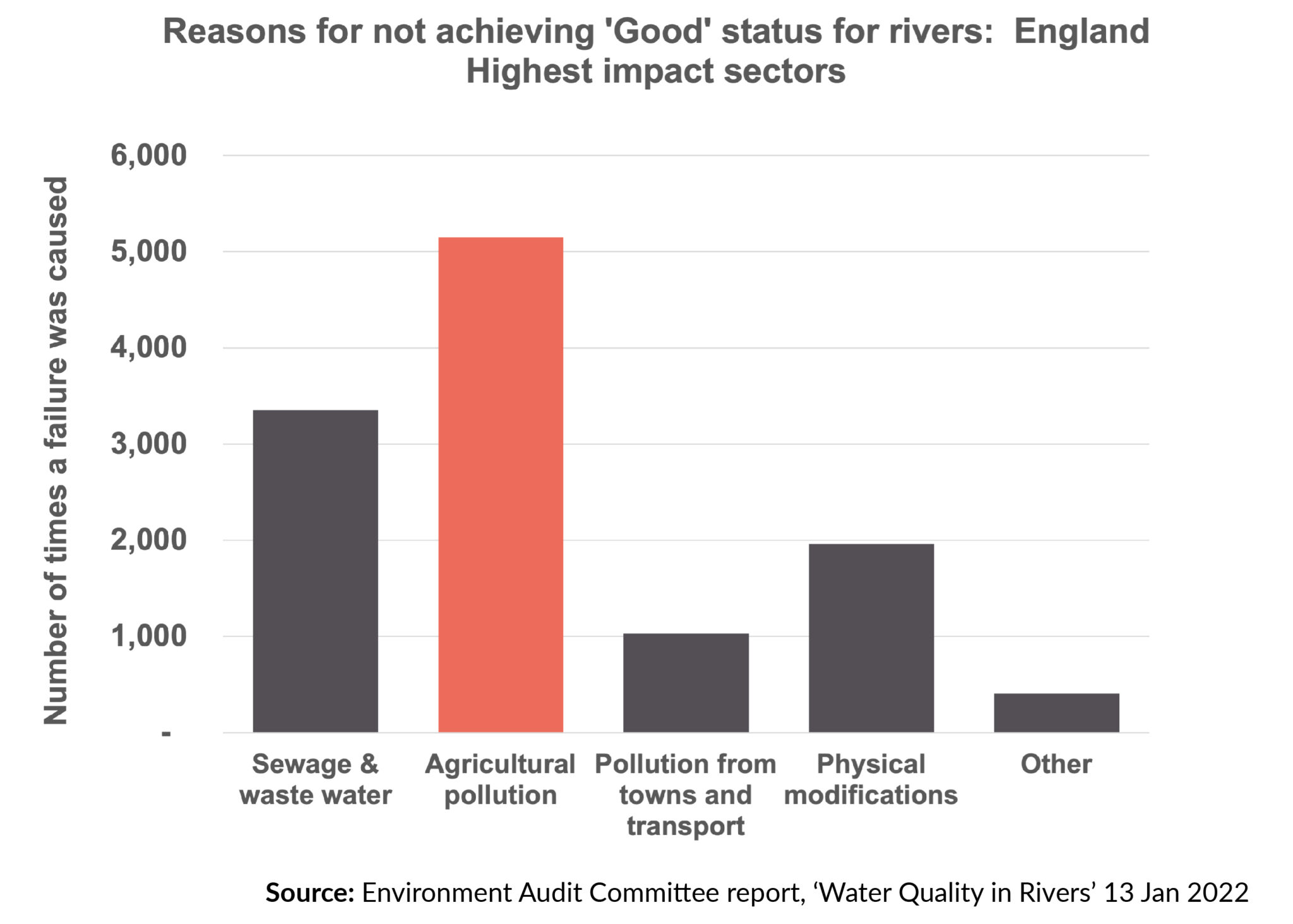
Unambitious targets on nitrogen and phosphorus
This pollution is devastating wild plant populations that are of critical importance to the wildlife food chain, including insects, birds and mammals. Excessive nitrogen in the environment is damaging soil and threatening our food security by killing microbes and other soil biodiversity, increasing acidity and causing declining fertility. The EIP recognises that soil health is a problem but contains no legally binding target to reverse this.
No Target for Pesticide Use
There are no legal targets to reduce pesticide use, despite UK having signed up to the COP15 pledge to reduce impact of pesticide by 50% by 2030. This gap will result in the failure of the ‘apex’ biodiversity target and the target for the ecological status of water bodies. A joint Soil Association and PAN UK study found that two thirds of river samples contained over 10 pesticides. Pesticides, along with habitat loss and climate change are devastating our wildlife. The RSPB reports that at least 150 different active ingredients were used on British farmland in 2020.
The Government is not tackling the sources of pollution through their targets. There is no target or timescale for the reduction and phasing out of pesticide or fertiliser use in the UK. Evidence shows that the UK pesticide use has been rising in recent years and the environment is saturated with a cocktail of chemicals in soil, water and air. Chemicals have accumulated in soils with extreme adverse effects:
- Damaging soil structure, preventing it from retaining water and growing without the use of chemicals
- Killing soil biodiversity, the basis of the food chain, also destroying soil’s ability to support our food system
- Toxins are leaching into ground water and running off into surface water
- Chemicals are combined creating a ‘cocktail effect’ greatly increasing toxicity of the individual compounds
- Pesticides are now so widespread that they are available to all types of wildlife in virtually all ecosystems.
Pesticides in our Food
- A European study called the Pesticide Atlas has confirmed that 83% of UK soil samples contain pesticide residues which can remain in soil more than 20 years after converting to organics.
- PAN UK reported in 2022 that the proportion of bread containing two or more pesticides has almost doubled in a year to 50%
- Children are exposed to pesticides – unacceptable levels were present in the food provided through the the Department of Health’s School Fruit and Vegetable Scheme (SFVS).
- The Soil Association and PAN UK reported in 2019 how the ‘cocktail effect’ is threatening human food and the environment. Finding that flowering plants, soil and river water, can contain 10 or more different pesticides in a single sample
No targets on livestock waste
Land and waterways are being polluted by animal waste, from grazing livestock as well as manure spreading. A 2018 Government report shows that ammonia, mostly from fertiliser and livestock waste, is polluting more than 60% of the UK’s land area—including statutory protected sites—and causing severe damage to biodiversity. Critical carbon sinks such as peatlands, woodlands and species-rich grasslands are particularly susceptible.
No targets on microplastic pollution or antimicrobial resistance
Plastics and human medicines, such as hormones and antibiotics, typically found in sewage sludge which is spread on land as fertiliser, finds its way back into the water system through run-off. The EIP acknowledges this but there is no plan to ban the practice.
There is no target or measure for monitoring and reducing plastic pollution in soil or in water bodies, including the sea.
OEP – ‘too much uncertainty to assess targets’
In its report assessing the Government’s progress on the environment, the Office for Environmental Protections says that it cannot assess the viability of the Government’s targets for water because they would need to be linked to guaranteed results delivered by the Environmental Land Management schemes (ELMs). But it says: “The status of land management schemes, which are critical for delivering this target, remains uncertain.” It also considers the release of land from agriculture (at least 20%) to be critical for water and biodiversity targets, as advocated by Natural England and the Climate Change Committee.
-
10. Too little focus on 'forever' chemicals
More info coming soon.
Information on PFAS ‘forever’ chemicals which we understand water bodies are largely not being tested for.
-
11. How significant is the promised £7.1 billion of new spending?
The Government has announced that water companies will invest £7.1 billion between 2020 and 2025, a total of just over £1 billion a year. This sounds like a lot, but the equivalent annual investment was over five times higher between 1991 and 1998 according to the Financial Times, when £5.7 billion was spent every year. Since then, investment has declined, despite a rising population and more extreme weather.
Considering the backlog of problems caused by decades of under-investment, and the higher population levels and greater surface water run-off due to climate change, this looks unambitious.
-
12. Solutions
Key Solutions
Nature-based solutions: See The Rivers Trust’s ‘Big Solutions‘.
Impose tougher legal requirements on water companies to “take all reasonable steps to reduce the harm caused by dumping sewage – from all parts of the sewage system” as proposed in the House of Lords (‘Wellington’) amendment. See FAQ (3) for detail. Water companies are still distributing large dividends and paying high levels of executive remuneration (charts below). They can do more, and should be obliged to.
Better funded active monitoring by the Environment Agency, with a duty for them to enforce the regulations – as proposed by the House of Lords – see FAQ (3) for detail. Self-reporting has been shown not to work. Yes, that means a significant increase in Environment Agency funding, reversing the funding cuts of previous years. But allowing our rivers and seas to deteriorate carries a huge cost, and this would be a worthwhile investment.
-
13. How the CAN Bill will help
Targets on Emissions
The CAN Bill aims to limit the United Kingdom’s carbon and other greenhouse gas emissions, including on imports, at rates consistent with limiting global heating to 1.5oC. Rapid global heating is placing enormous stress on natural ecosystems, and it is vital that we act faster on emissions to avoid ecosystems collapsing.
Climate change is a global phenomenon, and the CAN Bill would set a world-leading example which we hope will be emulated by nations.
Targets on Nature
- The CAN Bill’s nature target would ensure that the UK: “halts and reverses its overall contribution to the degradation and loss of nature in the United Kingdom and overseas” by 2030, on a baseline of 2020, so that “nature is visibly and measurably on the path of recovery”
- Government must create a strategy for climate and nature within12 months of enacting the Bill. To be consistent with the Bill’s requirement to reverse nature loss, that would mean work on halting water pollution from agriculture and water companies, as well as all other sources, backed by annual interim targets, monitoring and reporting.
- Work would have to begin to restore and expand natural and managed freshwater and marine ecosystems, as well as ecosystems that affect water quality, such as soil, woodlands and peatlands to: “protect and enhance biodiversity, ecological processes, and ecosystem service provision, including climate change mitigation”
- The Bill ensures that any “steps taken to mitigate emissions minimise damage to ecosystems, food and water availability, and human health”. This would include the implementation of renewable energy systems and nature-based solutions to mitigate and adapt to climate change.
- The Bill evokes the Mitigation and Conservation Hierarchy for any development projects that affect biodiversity and ecosystems (the vast majority). This transformative approach prioritises strict avoidance of the loss of nature, along with restoration; with local offsets minimised, and adopted as a very last resort.
- The Bill would introduce strict limits on the UK’s activities overseas that cause damage to ecosystems and extraction of raw materials and resources, such as water.
Fairness
The Bill would provide financial support and retraining for people whose livelihoods and jobs are affected by the proposed measures—including those transitioning out of industries characterised by high emissions and high impacts on ecosystems.
-
Key links / documents
Government
- Storm Overflows Discharge Reduction Plan – Aug 2022 – sets out the Government’s targets on reducing the dumping of raw sewage into rivers.
- Environmental Improvement Plan – Jan 2023
NGO and science links
- Marine Conservation Society
- The Rivers Trust
- A joint parliamentary briefing produced by Surfers against Sewage, Trout & Salmon Conservation, The Angling Trust, and The Rivers Trust
- www.top-of-the-poops.org: lists sewage dumps in detail. You can search for the results in your constituency.

